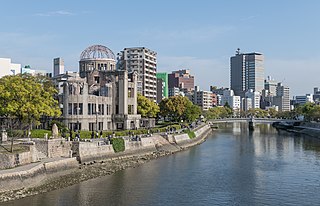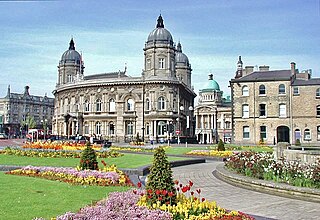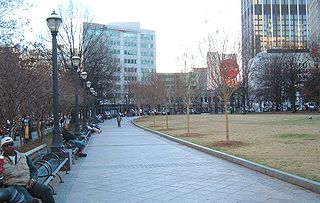
Hiroshima is the capital of Hiroshima Prefecture in Japan. As of June 1, 2019, the city had an estimated population of 1,199,391. The gross domestic product (GDP) in Greater Hiroshima, Hiroshima Urban Employment Area, was US$61.3 billion as of 2010. Kazumi Matsui has been the city's mayor since April 2011.

Hiroshima Prefecture is a prefecture of Japan located in the Chūgoku region of Honshu. Hiroshima Prefecture has a population of 2,811,410 and has a geographic area of 8,479 km². Hiroshima Prefecture borders Okayama Prefecture to the east, Tottori Prefecture to the northeast, Shimane Prefecture to the north, and Yamaguchi Prefecture to the southwest.

The Hiroshima Peace Memorial, originally the Hiroshima Prefectural Industrial Promotion Hall, and now commonly called the Genbaku Dome, Atomic Bomb Dome or A-Bomb Dome, is part of the Hiroshima Peace Memorial Park in Hiroshima, Japan and was designated a UNESCO World Heritage Site in 1996. The ruin of the hall serves as a memorial to the over 140,000 people who were killed in the atomic bombing of Hiroshima at the end of World War II. It is permanently kept in a state of arrested ruin as a reminder of the destructive effects of nuclear warfare.

Arrested decay is a term coined by the U.S. State of California, to explain how it would preserve its Bodie State Historic Park. A more common application of this concept is the preservation of war ruins as memorials.
Peace park is another name for a transboundary protected area

Sadako Sasaki was a Japanese girl who became a victim of the atomic bombings of Hiroshima and Nagasaki by the United States. She was two years of age when the bombs were dropped and was severely irradiated. She survived for another ten years, becoming one of the most widely known hibakusha—a Japanese term meaning "bomb-affected person". She is remembered through the story of the more than one thousand origami cranes she folded before her death. She died at the age of 12 on October 25, 1955 at the Hiroshima Red Cross Hospital.

Tadatoshi Akiba is a Japanese mathematician and politician and served as the mayor of the city of Hiroshima, Japan from 1999 to 2011.

Queen's Gardens is a sequence of gardens in the centre of Kingston upon Hull, England. They are set out within a 9.75-acre (4 ha) area that until 1930 was filled with the waters of Queen's Dock. As the dock was not fully filled in, the gardens are largely below the level of the surrounding streets.

Woodruff Park, named for Robert W. Woodruff, is located in the heart of Downtown Atlanta, Georgia. The park's 6 acres (2.4 ha) are north of Edgewood Ave, between Peachtree Street NE and Park Place NE. The park includes a fountain, a performance pavilion, and several monuments.
Peace Tower is the name of a number of structures erected in response to wars.

Hiroshima Peace Memorial Park is a memorial park in the center of Hiroshima, Japan. It is dedicated to the legacy of Hiroshima as the first city in the world to suffer a nuclear attack at the end of World War II, and to the memories of the bomb's direct and indirect victims. The Hiroshima Peace Memorial Park is visited by more than one million people each year. The park is there in memory of the victims of the nuclear attack on August 6, 1945, in which the United States dropped an atomic bomb on the Japanese city of Hiroshima. The Hiroshima Peace Memorial Park was planned and designed by the Japanese Architect Kenzō Tange at Tange Lab.

Naka-ku is the heart of Hiroshima, Hiroshima Prefecture, Japan. Naka-ku is home to Hiroshima's central business district and Peace Memorial Park. Major attractions include the Hondori shopping arcade, a covered mall-like street of shops extending east from the Hiroshima Peace Memorial Park to Hatchobori. Also in Naka-ku is Okonomi-mura - a building housing a number of restaurants that serve Hiroshima's famous food, okonomiyaki.

A peace museum is a museum that documents historical peace initiatives. Many peace museums also provide advocacy programs for nonviolent conflict resolution. This may include conflicts at the personal, regional or international level.

The Hiroshima Peace Memorial Museum is a museum located in Hiroshima Peace Memorial Park, in central Hiroshima, Japan, dedicated to documenting the atomic bombing of Hiroshima in World War II.

Atomic tourism or nuclear tourism is a recent form of tourism in which visitors learn about the Atomic Age by traveling to significant sites in atomic history such as museums with atomic weapons, missile silos, vehicles that carried atomic weapons or sites where atomic weapons were detonated.

The Peace Gardens are an inner city square in Sheffield, England.

The atomic bombings of Hiroshima and Nagasaki were the detonation of two atomic bombs over the Japanese cities of Hiroshima and Nagasaki on 6 and 9 August 1945 by the United States. The two bombings killed between 129,000 and 226,000 people, most of whom were civilians, and remain the only use of nuclear weapons in an armed conflict.
Seaforth Peace Park, formerly Seaforth Park, is a park in Vancouver's Kitsilano neighbourhood, in British Columbia, Canada. The park's name refers to the neighboring Seaforth Armoury.

The Erskine Memorial Fountain is a public fountain in Grant Park of Atlanta, Georgia, United States. Designed by J. Massey Rhind in honor of John Erskine, it was the first public fountain in Atlanta. The fountain was built in 1896 and moved to its current location in 1912.















